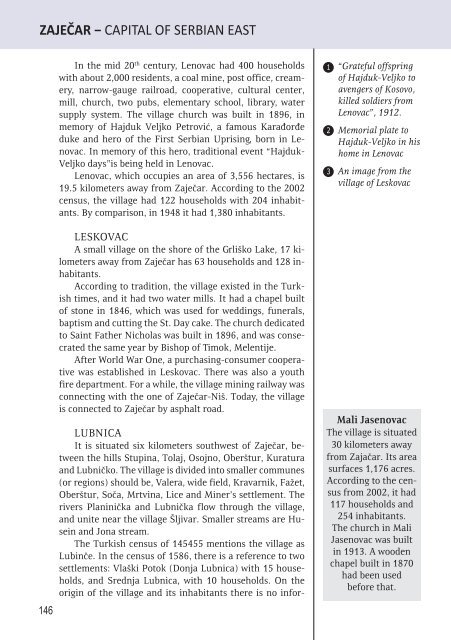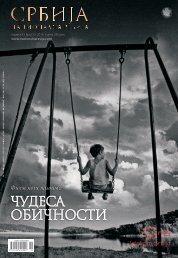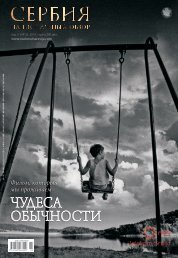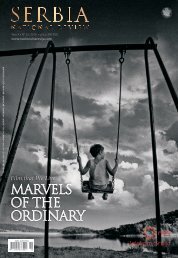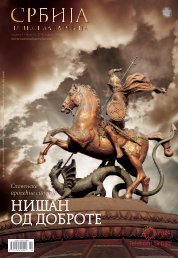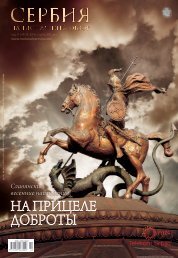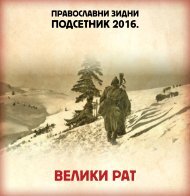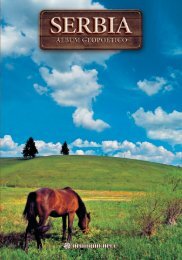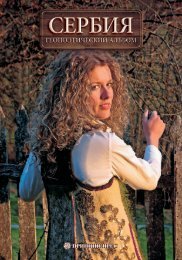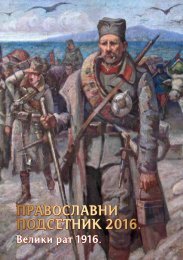Zajecar - engleski - niska rezolucija
You also want an ePaper? Increase the reach of your titles
YUMPU automatically turns print PDFs into web optimized ePapers that Google loves.
ZAJEČAR − CAPITAL OF SERBIAN EAST<br />
In the mid 20 th century, Lenovac had 400 households<br />
with about 2,000 residents, a coal mine, post office, creamery,<br />
narrow-gauge railroad, cooperative, cultural center,<br />
mill, church, two pubs, elementary school, library, water<br />
supply system. The village church was built in 1896, in<br />
memory of Hajduk Veljko Petrović, a famous Karađorđe<br />
duke and hero of the First Serbian Uprising, born in Lenovac.<br />
In memory of this hero, traditional event “Hajduk-<br />
Veljko days”is being held in Lenovac.<br />
Lenovac, which occupies an area of 3,556 hectares, is<br />
19.5 kilometers away from Zaječar. According to the 2002<br />
census, the village had 122 households with 204 inhabitants.<br />
By comparison, in 1948 it had 1,380 inhabitants.<br />
1<br />
2<br />
3<br />
“Grateful offspring<br />
of Haj duk-Velj ko to<br />
avengers of Ko so vo,<br />
killed soldiers from<br />
Le nov ac”, 1912.<br />
Memorial plate to<br />
Haj duk-Velj ko in his<br />
home in Le nov ac<br />
An image from the<br />
village of Le sko vac<br />
LESKOVAC<br />
A small village on the shore of the Grliško Lake, 17 kilometers<br />
away from Zaječar has 63 households and 128 inhabitants.<br />
According to tradition, the village existed in the Turkish<br />
times, and it had two water mills. It had a chapel built<br />
of stone in 1846, which was used for weddings, funerals,<br />
baptism and cutting the St. Day cake. The church dedicated<br />
to Saint Father Nicholas was built in 1896, and was consecrated<br />
the same year by Bishop of Timok, Melentije.<br />
After World War One, a purchasing-consumer cooperative<br />
was established in Leskovac. There was also a youth<br />
fire department. For a while, the village mining railway was<br />
connecting with the one of Zaječar-Niš. Today, the village<br />
is connected to Zaječar by asphalt road.<br />
LUBNICA<br />
It is situated six kilometers southwest of Zaječar, between<br />
the hills Stupina, Tolaj, Osojno, Oberštur, Kuratura<br />
and Lubničko. The village is divided into smaller communes<br />
(or regions) should be, Valera, wide field, Kravarnik, Fažet,<br />
Oberštur, Soča, Mrtvina, Lice and Miner’s settlement. The<br />
rivers Planinička and Lubnička flow through the village,<br />
and unite near the village Šljivar. Smaller streams are Husein<br />
and Jona stream.<br />
The Turkish census of 145455 mentions the village as<br />
Lubinče. In the census of 1586, there is a reference to two<br />
settlements: Vlaški Potok (Donja Lubnica) with 15 households,<br />
and Srednja Lubnica, with 10 households. On the<br />
origin of the village and its inhabitants there is no infor-<br />
146<br />
Ma li Ja se no vac<br />
The village is situated<br />
30 kilometers away<br />
from Zajačar. Its area<br />
surfaces 1,176 acres.<br />
According to the census<br />
from 2002, it had<br />
117 households and<br />
254 inhabitants.<br />
The church in Ma li<br />
Ja se nov ac was built<br />
in 1913. A wooden<br />
chapel built in 1870<br />
had been used<br />
before that.


